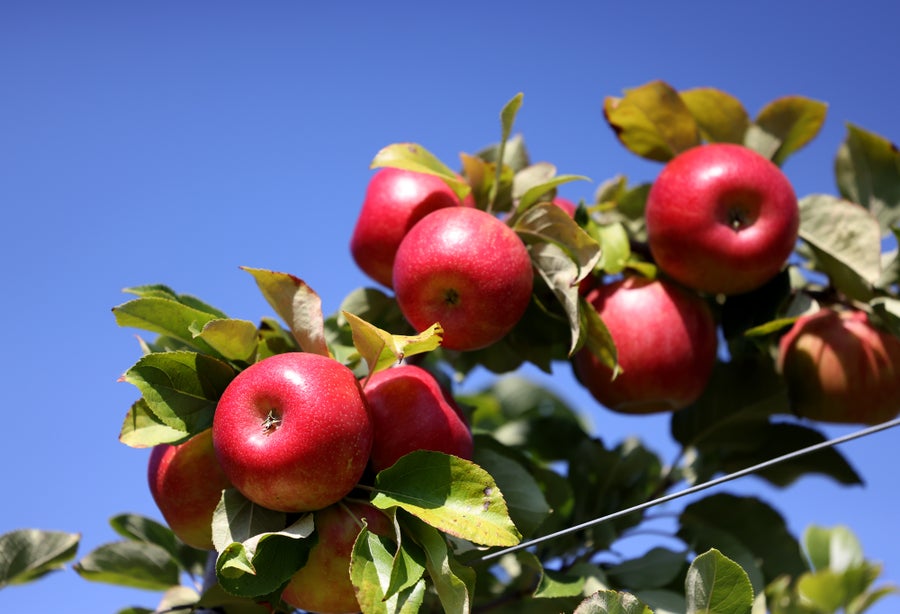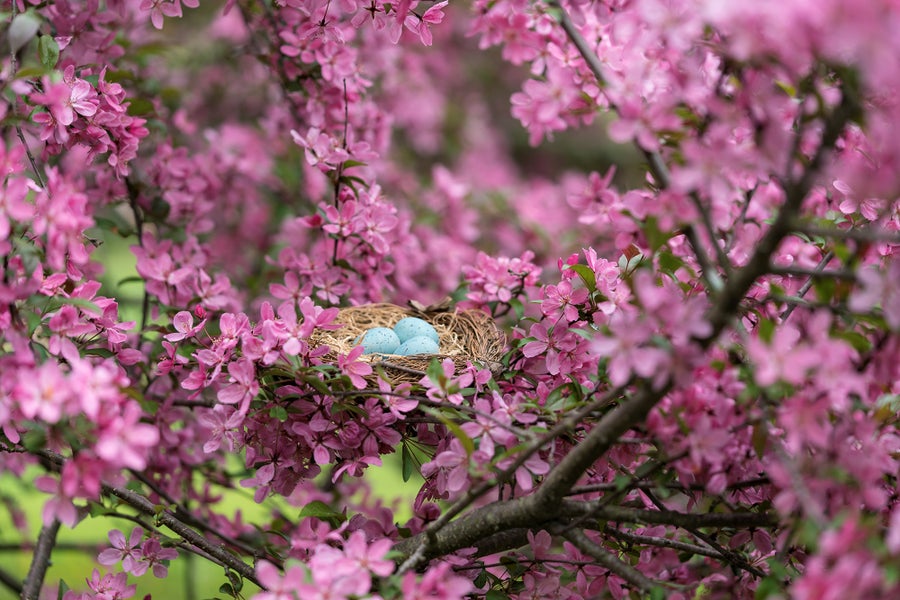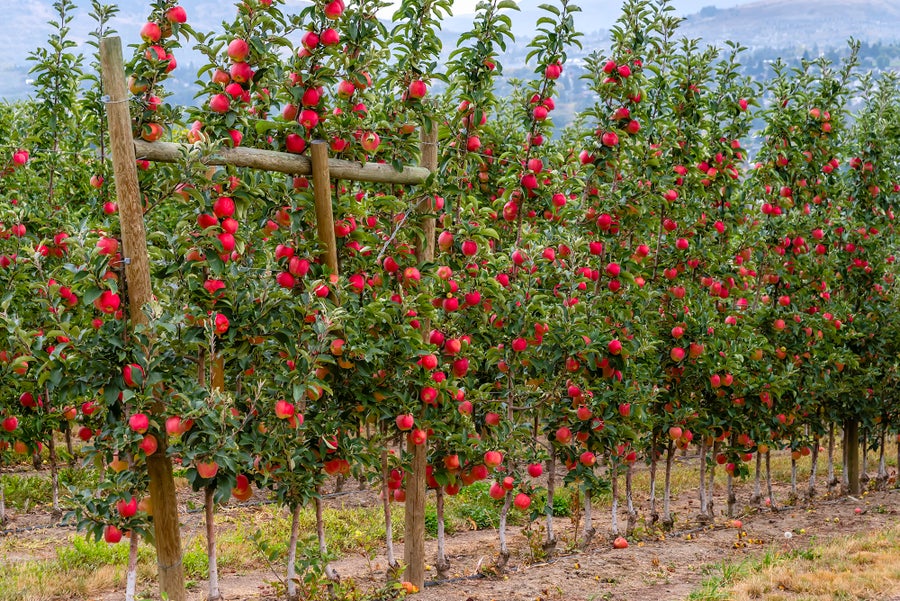We are living in a golden age of apples, a time of delicious, diverse, mouth-watering abundance that we could barely have imagined at the turn of the millennium. How did we get to a time when most of us, most of the year, can eat our choice of fragrant, juicy, sweet, crisp (oh so crisp) apples?
We can thank a mix of science, innovations, investment in long-term research, the multi-multi-multi-generational transmission of knowledge, communal action and people who joyfully dedicate their lives to a cause.
What’s your favorite apple? I asked this question on the social media platform Bluesky, and this is a sample of people’s answers: Macoun, Winesap, Gravenstein, Winter Banana, CrimsonCrisp, SnapDragon, SweeTango, Jazz, Cosmic Crisp, Jonathan, Empire, Envy, RubyFrost, Hidden Rose, Sonata, Pink Lady, Regent, Honeycrisp, Honeycrisp, Honeycrisp. (My favorite? Evercrisp.)
On supporting science journalism
If you’re enjoying this article, consider supporting our award-winning journalism by subscribing. By purchasing a subscription you are helping to ensure the future of impactful stories about the discoveries and ideas shaping our world today.
Many of us remember that the U.S. apple market was dominated for decades by one variety: Red Delicious, which is a bold name for a bland apple. It is certainly red, with a lovely rich jewel color and a handsome shape. But delicious? The main alternative was Golden Delicious, a perfectly fine but similarly uninspiring yellow variety. Tart, green Granny Smiths, which were propagated in Australia in 1868 by an orchardist named Maria Ann Sherwood Smith, started taking a decent share of the market in the U.S. in the 1980s. And that’s where we were stuck.
David Bedford, an apple researcher at the University of Minnesota who helps develop new varieties (his favorite apples: Honeycrisp, SweeTango and Rave) says, “I still remember some big marketers telling me: we have a red apple, a yellow apple, and a green apple. Do we really need any more?”
Apple History
Today’s cultivated apples are produced by the tree Malus domestica. Its ancestor is Malus sieversii, which still grows wild in what is now Kazakhstan and bears small and variable fruit. Farmers began domesticating apples sometime between 10,000 and 4,000 years ago in the Tian Shan Mountains of Central Asia, according to genetic analyses. These cultivated varieties then quickly spread along the Silk Road trade route, where breeders crossed them with another wild species, Malus sylvestris. The ancient Romans developed techniques for apple grafting (more on that in a sec) and propagated the trees across their empire.
It’s a little challenging to track the cultural history of apples because in many languages, the word that came to mean “apple” could refer to any type of fruit. There weren’t apples in Mesopotamia, for instance, so the tempting fruit in the Garden of Eden story was more likely a fig. When the Greek goddess of discord inscribed a fruit with “For the most beautiful” and started the Trojan War, that fruit may have been a quince. And William Tell probably didn’t shoot an arrow through an apple on top of his son’s head. Isaac Newton wasn’t hit on the head, but he did say that observing an apple falling from a tree helped inspire his theory of gravity.
Some legends are based in fact: Apples really were planted across the U.S. Midwest by John Chapman, an eccentric missionary nicknamed Johnny Appleseed. These apples were for juicing and fermenting into hard cider rather than eating. Some cider orchards went under during Prohibition, and many small-hold and backyard orchards were lost to disease or abandoned as people moved to cities. Industrial orchards specialized in a few varieties, and many specialty or rare varieties were no longer cultivated. A modern real-life legend named Tom Brown has rediscovered and saved about 1,200 historic apple varieties in Appalachia.
During the 20th century, people lucky enough to live near local orchards could eat distinctive regional apples. But these apples usually weren’t produced in enough abundance to ship widely, and they were available only seasonally. (If you live within driving distance of Dickerson, Md., I highly recommend Kingsbury’s Orchard, which has been in business since 1907 and is always experimenting with new varieties.) But for most of the world, most of the time, you had only a few mass-produced varieties to choose from. In the U.S. that meant red, yellow or green.
Before Honeycrisp and after Honeycrisp
Do you remember the first time you tasted a Honeycrisp apple? Bedford sure does. It was the 1980s, and he had recently started a job at the agricultural school of the University of Minnesota to work on fruit crops. “I can’t remember all the things that swirled in my brain,” Bedford says, “but one was the question ‘What is this?’” The Honeycrisp he sampled as a test crop was so different from the Red Delicious apples he had grown up with, “and my knowledge was so limited that I was a little uncertain: ‘Is this okay? Is this all right?’” But it didn’t take him long to figure out that “not only is it all right but excellent.”
Honeycrisp has a “disruptive trait,” says Chris Gottschalk, a geneticist who works at the U.S. Department of Agriculture’s research station in Kearneysville, W.V. (his favorite apples: Honeycrisp and Golden Russet). Honeycrisp’s texture—the crispness—had never been combined with a high-acidity, high-sugar apple, he says. “That really struck North American consumers specifically well,” Gottschalk says. As its popularity grew, it went from being largely a “u-pick” fruit to becoming regionally available in groceries, and now it is the third most produced apple in the U.S.
Bedford says the world of commercial apples has two phases: before Honeycrisp and after Honeycrisp. Before, there were basically two categories to describe texture, he says: soft/mealy or hard/firm/dense. “With Honeycrisp, we had to redefine what texture was,” Bedford says. That texture was so distinctive and delightful that it has become the basis for many of our new apple varieties, which is why such a large number of them have the word “crisp” in their name. “Once you’ve had crisp,” he says, “it’s hard to go back.”

Honeycrisp apples have a “disruptive trait” that changed consumer demand.
Jessica Rinaldi/The Boston Globe via Getty Images
Honeycrisp inspired consumer demand for excellent tasting apples, and that changed the apple market. “It wasn’t that consumers wanted Red Delicious” back in the day, Bedford says. “They just didn’t have any choice.”
Paul Francis, an apple buyer for Giant grocery stores, says the company now carries more than 20 varieties throughout the year, twice the assortment it carried 10 years ago. He says, “The demand for premium variety apples has increased over the past few years dramatically.” The grocery chain’s most popular specialty varieties are Honeycrisp, Gala and Fuji. He and his produce team are particularly excited about some even newer varieties, including Hunnyz, SugarBee, Cosmic Crisp, Wild Twist and Evercrisp.
The most produced varieties across the U.S. in the 2023–2024 growing season, according to the U.S. Apple Association, a trade organization, are Gala, Red Delicious, Honeycrisp, “others” (including all the new and specialty varieties that don’t yet rank individually) and Fuji. Cosmic Crisp is climbing up the charts while Red Delicious is plummeting as a proportion of all apples produced.
How to Breed a Better Apple
One common misconception about apples is that they “breed true,” says Susan Brown, an apple researcher at Cornell University’s College of Agriculture and Life Sciences. They don’t: if you plant a Gala seed, you won’t grow a tree that produces Gala apples. (Brown’s favorite apple: “SnapDragon, without a doubt,” she says. Her team cultivated SnapDragons and they were served at her daughter’s wedding.) Apples don’t self-fertilize; one tree’s flowers need pollen from a different tree. That means any seed from a Gala apple is 50 percent Gala and 50 percent “whatever the bee brought,” Brown says. Even the seeds within a given apple can have different genetic compositions. So when you’re developing new varieties, she says “you play the genetic lottery every time.”
Breeders start with a parent tree and cross it with another variety that they think will make a favorable combination of traits. (When one parent is a Honeycrisp, the offspring typically inherit the “Crisp” name.) At the USDA, Gottschalk and his colleagues use a glass rod to painstakingly rub pollen from the other parent’s stamen onto the flowers’ style and stigma to control fertilization. Other breeders may throw a net over a blossoming tree, stick a bouquet of flowering boughs from another tree inside the net, put some bees in and, Gottschalk says, “let the bees do the work for you.”

Apple blossoms are fertilized by “whatever the bee brought in.”
Marcia Straub/Getty Images
Once the blossoms are fertilized, the parent tree produces apples, and their seeds are harvested, chilled for a season and sprouted. After a few months, when the new crosses are at the seedling stage, they can be tested for the presence of absence of certain genes.
The apple genome is enormous, complex and highly variable, and even with controlled fertilization, you don’t know which versions of a gene (called alleles) from the parent trees made it through to the seedlings. Most interesting qualities are influenced by many genes. Brown says one of the surprises over the course of her career studying apple genetics has been “the complexity of traits we thought would be easy.” There’s always another gene or transcription factor involved.
But there are a few genetic markers that breeders can screen for at the seedling stage, Gottschalk says, that give a good indication of acidity, skin color, resistance to certain diseases or the “crisp” trait in Honeycrisp and its progeny. The seedlings with the right constellation of traits are allowed to develop and go through the grafting process.
Grafting is the only way to “fix the genetics,” Brown says. New seedlings or branches that produce the desired fruit are notched into a “rootstock” apple tree. The rootstock provides structure and nutrition for its newly grafted branches, but it does not determine the shape, flavor or other qualities of the apples produced by the grafts, which are essentially all clones. (Fertilization doesn’t make a difference for how an apple turns out, either; whatever the bees bring in determines only the genes in its seeds.)
One of the great advances in apple breeding in the past few decades has been the widespread use of dwarf rootstocks. These trees mature quickly at a smaller size than traditional apple trees but can still support a lot of grafts. A greater proportion of energy can then go into growing apples rather than developing thick, tall, gnarly trees. Breeders can plant the trees closer together to make test plots more efficient, and boughs grafted to a dwarf rootstock start producing apples two to three years earlier than those grafted to a traditional rootstock.

Apple varieties grafted to dwarf rootstock start to fruit years before those grown on larger rootstock.
Birkus-Viktor/Getty Images
And that’s when the fun begins because a big part of an apple breeder’s job is tasting apples. “We have many sophisticated tests to measure firmness, texture, Brix (the amount of dissolved sugar) or acidity,” Brown says, “but there is no substitute for biting and eating the apple, so that is a large part of the process. Yes, we get upset stomachs, but one good apple makes up for it.”
“At the peak of crunch times, I’ve had to taste 600 apples a day,” Bedford says. “The first 100 are okay, but after that, it gets to be real work.”
No robot or genetic test can determine whether a new hybrid apple is good or not. People decide whether an apple is worth cultivating. And most of them are not. “Even with careful breeding and DNA analysis, only a small percentage are good enough” Bedford says. “In the best case, we get some combination of genes we didn’t fully see in either parent, and that’s exactly what Honeycrisp was.”
Apple breeders continue to test new varieties for five to 15 years after the initial taste test to screen for disease resistance, heat resilience, winter hardiness, the ability to bear every year (some bear only every other year) and other traits. “They all have bad traits; there’s no perfect apple,” Bedford says. He estimates that only one out of 10,000 seedlings he and his colleagues develop are good enough to release commercially.
What’s Next for Apples
I spoke with several apple researchers while working on this story, and do you know who loves their jobs? Apple researchers. And that’s not just because they get to taste new varieties all the time and spend workdays in an orchard. All of them, as well as the other orchardists and hobbyists I know, are proud of the progress they’ve made in the past few decades and optimistic about the future.
One of the biggest challenges to developing new varieties is that the ones we have now are so good. “The bar has risen so much,” Bedford says. Any new apple variety must be better than what already exists to justify developing it and bringing it to market. “We are some of our biggest competition,” he says. But every year a few of those 600 apples a day he bites into have a different combination of qualities that make them worth developing, something never tasted before.
Apple researchers are busy. Brown, Bedford and Gottschalk spend about as much time in the lab as they do in their test orchards. They’re looking for more genes associated with favorable (or unfavorable) traits. They’re working on apples that are well suited to selling as slices. They’re making crosses that have the right qualities for hard cider. And some breeders are developing new varieties of small apples that a child can easily hold and eat. Isn’t that adorable?
The technology for storing apples is improving quickly, and new varieties are being bred to stay firm for longer. Packing houses are experimenting with ways to control temperature, balance oxygen and carbon dioxide levels and scrub out ethylene gas that promotes ripening and rotting. Brown once tasted an apple that had been stored for three years, and she says she never would have guessed it was that old. Researchers are hoping to make apples last a full year in storage, expanding when and where they can be sold. (Some apple varieties available now can last for months in a home refrigerator, so stock up on Pink Ladies and Evercrisps when the apple season starts to wind down.)
A lot of apple advancements have been made possible by long-term investment in research at the USDA and universities, as well as collaborations and communication among labs and growers and buyers. Gottschalk’s team at the USDA, for instance, specializes in creating parent trees with lots of favorable traits that breeders at universities or commercial growers can use to cross with other parents and experiment with new varieties. Apples aren’t a hugely profitable industry, and it takes a long time to determine whether a new variety will be a success, so funding this sort of research makes it all possible.
“The work that my predecessors and academics have done has laid the groundwork to rapidly accelerate innovation in apples,” Gottschalk says. “In the next 15 to 20 years, we’re going to see apples that address consumer traits, have fruits that are more resilient to disease and stress and are more efficient and sustainable and profitable.” And they will be even more delicious (truly delicious, not Red Delicious).
What a great time to be alive. What a great time to be snacking. Isn’t it a joy to hold a pinnacle of human achievement in your hand … and take a bite?

